By Gerry Doyle, Samuel Granados, Michael Ovaska and Prasanta Kumar Dutta
PUBLISHED MARCH 10, 2022
Russia’s invasion of Ukraine began on Feb. 24 with strikes from land, sea and air in the largest military assault by one European state on another since World War Two. Despite an initial battle plan that Western countries said was aimed at swiftly toppling Ukraine’s government in Kyiv, Russia has control of only one Ukrainian city so far - the southern Dnipro River port of Kherson.
During the first week of war, Russia shifted from 1 strategic strikes against military targets using cruise missiles to a 2 stalled ground attack and, currently, a broader 3 siege of major cities, including bombardments using rocket artillery and cluster munitions, sometimes against residential buildings and civilian infrastructure. Moscow denies targeting civilians, and calls its actions in Ukraine a “special military operation” to disarm its neighbour and remove leaders it considers dangerous nationalists. Ukraine and Western allies call it an unprovoked invasion that has killed hundreds of civilians.
As the invasion heads into its third week, hundreds of thousands of people in Mariupol, the main port of eastern Ukraine, have been surrounded and under heavy bombardment, with no water or power or way to safely evacuate the wounded, officials there say. In Kharkiv and Kyiv, missiles hit residential buildings. Millions of Ukrainians have already fled the country as refugees.
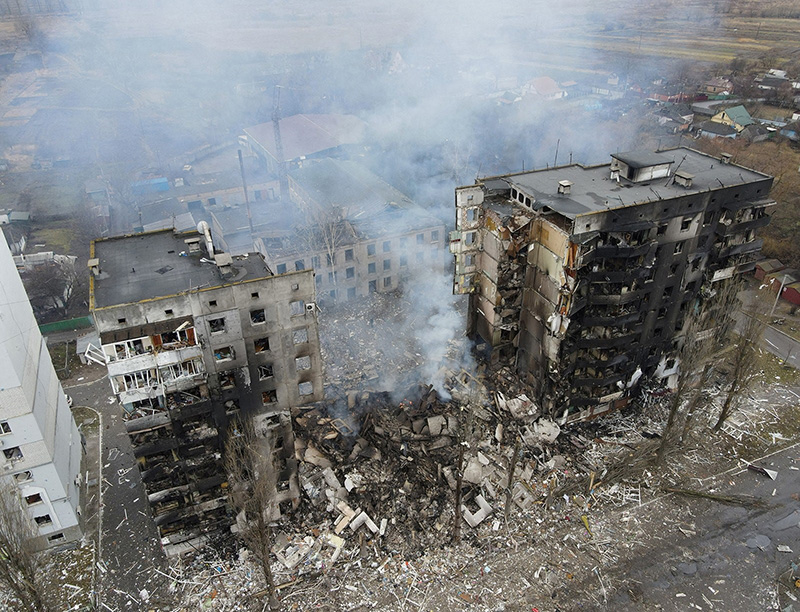
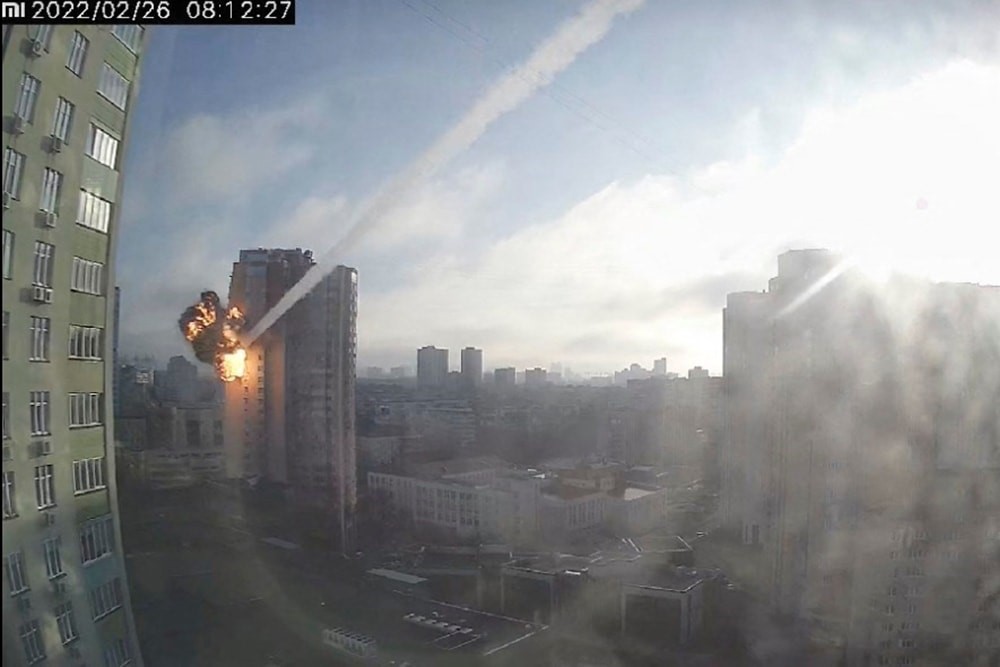
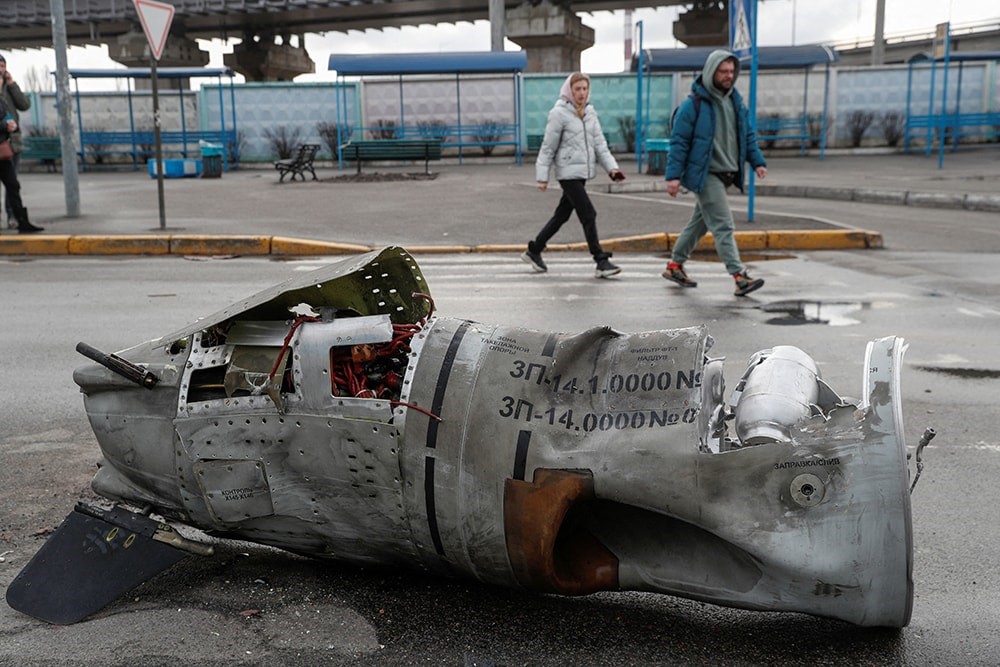
A Reuters picture taken with a drone shows a residential building destroyed by shelling in the settlement of Borodyanka in the Kyiv region, Ukraine March 3, 2022. Surveillance footage shows a missile hitting a residential building in Kyiv, Ukraine, February 26, 2022, in this still image taken from a video obtained by REUTERS. A Reuters picture shows people walking past the remains of a missile at a bus terminal in Kyiv, Ukraine March 4, 2022.
Top – A residential building destroyed by shelling in the settlement of Borodyanka in the Kyiv region, Ukraine March 3, 2022. Picture taken with a drone. REUTERS/Maksim Levin
Left – Surveillance footage shows a missile hitting a residential building in Kyiv, Ukraine, February 26, 2022, in this still image taken from a video obtained by REUTERS
Right – People walk past the remains of a missile at a bus terminal in Kyiv, Ukraine March 4, 2022. REUTERS/Valentyn Ogirenko
1 Targeted missile attacks
During the initial hours of the invasion, cruise missiles were widely deployed, and precision short-range ballistic missiles (SRBMs) were fired en masse in a war for the first time. According to U.S. estimates, the first Russian onslaught included more than 100 missiles launched from land and sea.
First day of attacks
Russian air and missile strikes against Ukrainian military sites and infrastructure on Feb. 24
Map showing the location of Russian air and missile strikes against Ukrainian military sites and infrastructure on Feb. 24
Russian air and missile strikes against Ukrainian military sites and infrastructure on Feb. 24
BELARUS
Chernobyl Nuclear Power Plant
captured by Russia
Residential area attacked, six civilians killed
RUSSIA
Residential block attacked
POLAND
Kyiv
Sumy
Lutsk
Kharkiv
Brody
Lviv
Chuhuiv
Myrhorod
Kalynivka
Blyznyuki
Krasnopillya
UKRAINE
Ivano-Frankivsk
Kramatorsk
MOLDOVA
Mariupol
Kulbakino
Odessa
Melitopol
Kherson
ROMANIA
Sea of Azov
Black Sea
CRIMEA
Estimated population density 2020
High
Low
Note: The Crimean peninsula was annexed by Russia in 2014, but the region is not internationally recognised as part of Russia
Source: Janes, open-source defence intelligence provider; Natural Earth; United Nations Office for the Coordination of Humanitarian Affairs (OCHA); Worldpop.org
Russia most likely used its only SRBM in active service, the Iskander-M, said Timothy Wright, a research analyst with the International Institute for Strategic Studies (IISS).
Ukraine has a limited supply of much older ballistic missiles, the OTR-21 Tochka, and in the first days of the war used at least one to attack a Russian air base inside Russia, according to media reports.
Illustration of a 9K720 Iskander, a road-mobile short-range ballistic missile (SRBM) with a range of up to 500 km. Using a common transporter-erector-launcher and support vehicles, the system can also fire cruise missiles.
7.3m
9K720 Iskander
Russia
ORIGINATED FROM
2006
IN SERVICE
400-500km
RANGE
700kg
PAYLOAD
2 ballistic or cruise missiles
CAPACITY
Source: Center for Strategic and International Studies
According to the IISS, the Iskander-M has greater range than the Tochka and its launchers can carry more than one missile. Each Iskander launcher has an armoured cover for the missiles, and its cabin is hardened against chemical, biological, radiological, and nuclear hazards, as well as extreme temperatures. The vehicle can drive off-road and can travel at speeds up to 70 km/h (43 mph) for 1,100 km (684 miles). The Iskander-M has circular error probable (CEP) of 5-7 metres, meaning half of the projectiles fired will land in a circle with a radius of that size. The Tochka, by contrast, has a CEP of 90m.
On Friday, Feb. 25, Ukraine's military command said areas near the cities of Sumy, Poltava and Mariupol were hit by Russian 3M14 Kalibr cruise missiles launched at the country from the Black Sea.
The Kalibr is a land-attack cruise missile (LACM) with an estimated range of 1,500 to 2,500 km. Meant for precision strikes, its exact CEP is unknown but is estimated to be less than 5m.
Illustration of the 3M14 Kalibr, a Russian land attack cruise missile with an estimated range of around 1,500 to 2,500 km that has become a mainstay in the Russian Navy’s ground-strike capabilities.
6.2 m
3M14 Kalibr
RUSSIA
ORIGINATED FROM
2015
IN SERVICE
1,500km - 2,500km
RANGE
450kg
PAYLOAD
Sea and air-launched Land Attack Cruise Missile
CLASS
Source: Center for Strategic and International Studies
Some Russian strikes at air bases appeared relatively limited, however, and in instances missed vital targets, such as hitting stored rather than operational aircraft, said Joseph Dempsey, a defence researcher at IISS. Ukraine has the Cold War-era Russian-made S-300v anti-aircraft missile system, which also has anti-ballistic missile capabilities, Wright said. It is unclear whether any engaged the Russian missiles, and some S-300v vehicles appeared to have been destroyed by strikes, he added.
As Moscow failed to swiftly overthrow Ukraine's government in the first days of the attack, the results of its missile campaign appear to have been mixed at best. Although vastly outmatched by Russian airpower in terms of size, Ukraine’s air force is still operating, and experts say its air defences remain viable - a fact that has baffled some military analysts.
2 Stalled ground war
In the two main fronts in the east and north, Russia so far has little to show for its advance, with Ukraine's two biggest cities, Kyiv and Kharkiv, holding out in the face of increasingly intense bombardment.
Ukrainian civilians are supporting regular troops as they try to repel Russia's advance, including through civil defence units and independent militia that have formed across the country.
Urban guerrilla
The use of unconventional warfare in urban environments has become one of the main challenges for Russian forces. Buildings and trees in densely populated areas serve as hiding places for the Ukrainian soldiers.
Illustration showing unconventional warfare by the Ukrainian forces. The population has been asked to remove road signs to make it difficult for Russian soldiers to orient themselves. The Ukrainian government is using social media to share instructions on how to throw Molotov cocktails at vulnerable areas of Russian vehicles. Ukrainians have made metal anti-tank barricades known as "hedgehogs", and smaller spiked barriers aimed at stopping wheeled vehicles.
Guerrilla
Molotov cocktail
Barricades
MBT
BMP
Infantry fighting vehicle
Main battle tank
The population has been asked to remove road signs to make it difficult for Russian soldiers to orient themselves.
The Ukrainian government is using social media to share instructions on how to throw Molotov cocktails at vulnerable areas of Russian vehicles.
Ukrainians have made metal anti-tank barricades known as "hedgehogs", and smaller spiked barriers aimed at stopping wheeled vehicles.
A video shows workers making anti-tank barriers and cars driving around Jersey barriers and obstacles in streets.
Russian forces are becoming increasingly frustrated by what the United States believes is a viable and very determined Ukrainian resistance even as Moscow has committed almost all of the forces set aside for the invasion, U.S. defence officials said this week.
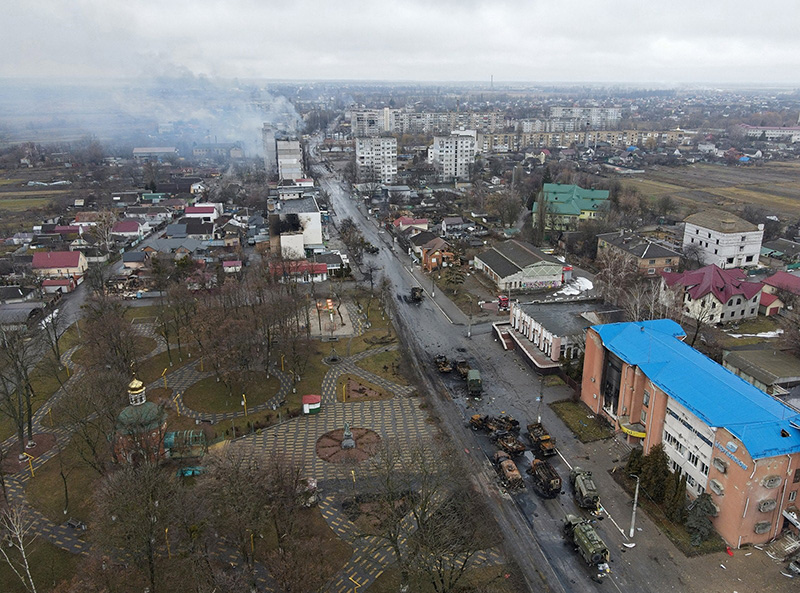
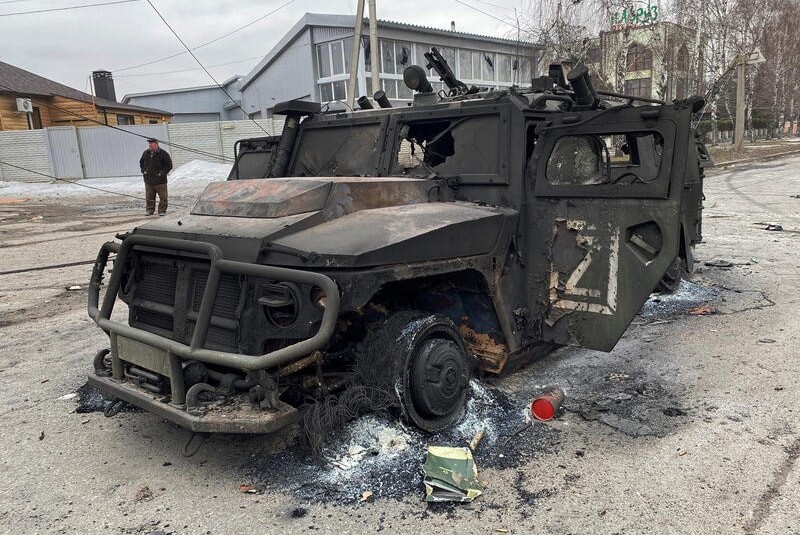
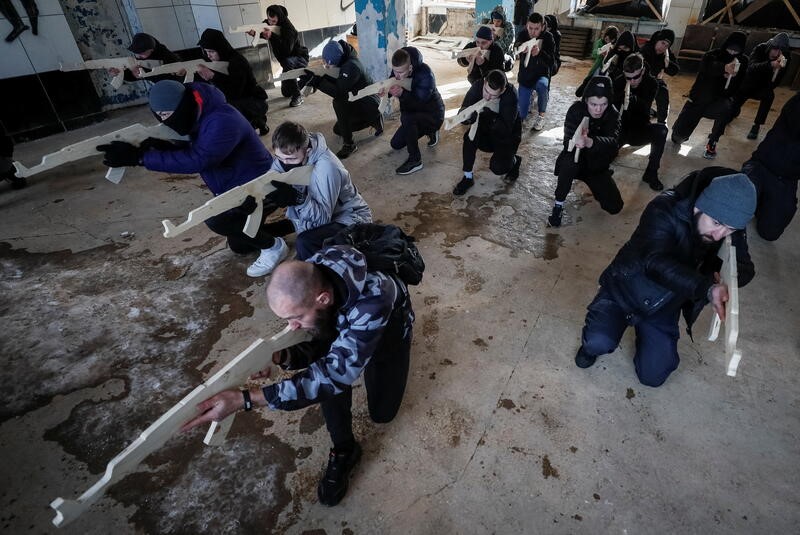
A Reuters picture taken with a drone shows a residential building destroyed by shelling in the settlement of Borodyanka in the Kyiv region, Ukraine March 3, 2022. A second Reuters photo shows a destroyed Russian Army all-terrain infantry mobility vehicle Tigr-M (Tiger) on a road in Kharkiv, Ukraine February 28, 2022. A third Reuters photo shows people taking part in a military exercise for civilians conducted by veterans of the Ukrainian National Guard Azov battalion, amid threat of Russian invasion, in Kyiv, Ukraine February 6, 2022.
Top – A residential building destroyed by shelling in the settlement of Borodyanka in the Kyiv region, Ukraine March 3, 2022. Picture taken with a drone. REUTERS/Maksim Levin
Left – A destroyed Russian Army all-terrain infantry mobility vehicle Tigr-M (Tiger) on a road in Kharkiv, Ukraine February 28, 2022. REUTERS/Vitaliy Gnidyi
Right – People take part in a military exercise for civilians conducted by veterans of the Ukrainian National Guard Azov battalion, amid threat of Russian invasion, in Kyiv, Ukraine February 6, 2022. REUTERS/Gleb Garanich
The United States and European nations have supplied Ukraine with a variety of hardware, including advanced weapons that can destroy armoured vehicles. These missiles can be particularly effective in urban settings, with more opportunities for teams to conceal themselves for ambushes.
Among these weapons are the NLAW, the next-generation antitank missile system developed jointly between UK and Sweden, and the FGM-148 Javelin, a U.S. lightweight system that can destroy tanks from several kilometers away.
Illustrations showing the technical specifications of two anti-tank weapons used by the Ukrainian army. NLAW, the next-generation antitank missile system developed jointly between UK and Sweden, and the FGM-148 Javelin, a U.S. lightweight system that can destroy tanks from several kilometers away.
NLAW
UK/Sweden
ORIGINATED FROM
20m – 800m
RANGE
Disposable
LAUNCH UNIT
150mm
CALIBRE
1.02m
MISSILE LENGTH
12.5kg
WEIGHT
Top attack
Direct attack
Javelin
US
ORIGINATED FROM
65m to 4km in most operational conditions
RANGE
Reusable
LAUNCH UNIT
14.2cm launch tube
DIAMETER
119.8cm launch tube
LENGTH
15.5 kg all-up round
WEIGHT
Top attack
Direct attack
Source: Saab; Lockheed Martin; Military Today
Photos from Ukraine have shown abandoned Russian vehicles, including tanks, raising questions about logistical failures alongside Ukranian attacks. "They simply don't have a lot of experience moving on another nation state at this level of complexity and size," a senior U.S. defence official said of the Russian army.
The official said it was unclear whether it was a failure in planning or execution, but added that Russian forces were likely to adapt and change the way they operate.
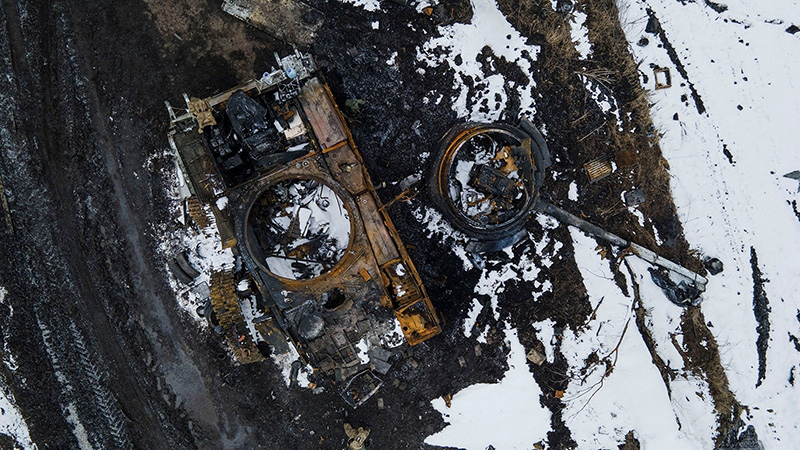
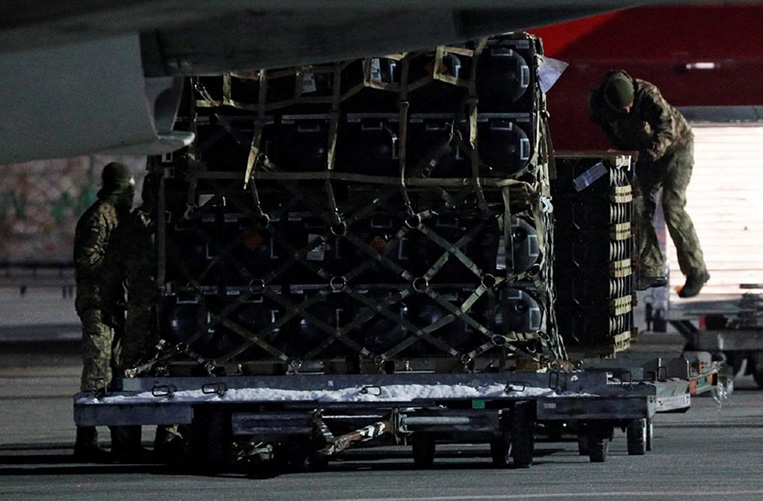
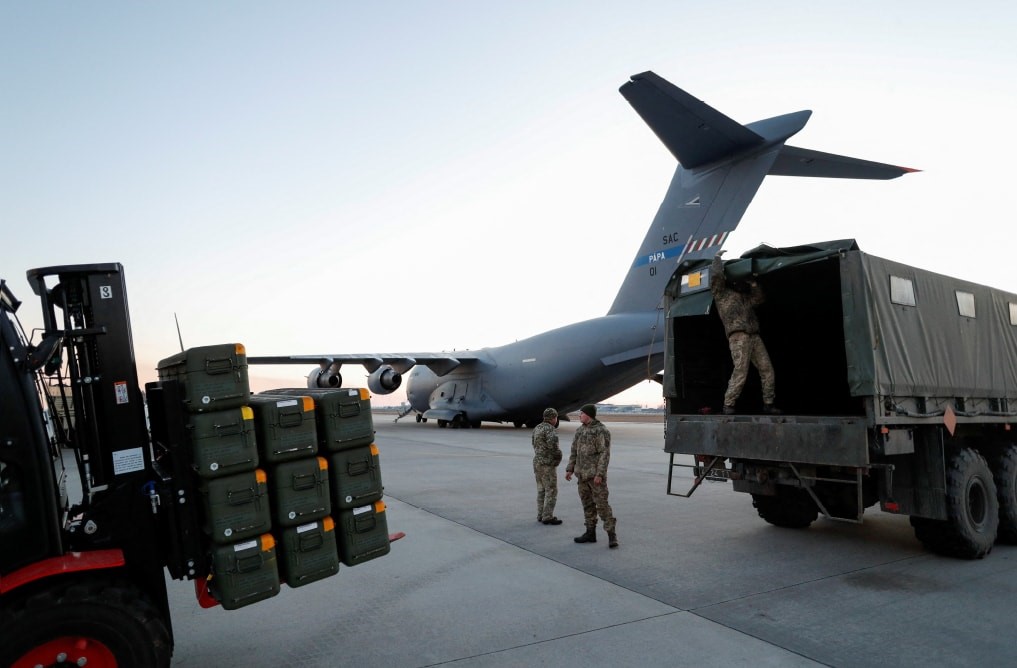
A handout photo from the press service of the Ukrainian Ground Forces shows a charred Russian tank is seen in the Sumy region, Ukraine, March 7, 2022. A second photo shows Ukrainian service members unloading a shipment of military aid delivered as part of the U.S's security assistance to Ukraine on January 25, 2022. A third photo shows Lithuania's military aid including Stinger anti-aircraft missiles on February 13, 2022.
Top – A charred Russian tank is seen in the Sumy region, Ukraine, March 7, 2022. Picture taken March 7, 2022. Irina Rybakova/Press service of the Ukrainian Ground Forces/Handout via REUTERS
Left – Ukrainian service members unload a shipment of military aid delivered as part of the U.S's security assistance to Ukraine on January 25, 2022. REUTERS/Gleb Garanich
Right – Lithuania's military aid including Stinger anti-aircraft missiles, delivered as part of the security support package for Ukraine on February 13, 2022. REUTERS/Valentyn Ogirenko
Another tool that has become important for Ukrainians in their fight is the Bayraktar TB2 unmanned combat aerial vehicle - a Turkish-made drone that can carry small anti-armor weapons. Ukraine's ambassador to Ankara, Vasyl Bodnar, has said the drones had been very efficient; videos posted by Ukraine’s military showed them being used to destroy vehicles in Russian convoys. Turkey has sold Kyiv several batches of TB2 drones, which it had deployed against Russian-backed separatists in eastern Ukraine.
The drone can carry small anti-vehicle weapons, most likely the Roketsan MAM-L “smart micro munition,” which follows a laser to its targets and can glide up to 8 km before impact, according to its manufacturer. The bombs weigh only 22kg but are designed to use a small charge to punch through armor and destroy a vehicle.
Illustration showing the technical specifications of the Turkish Bayraktar TB2 drone used by Ukraine. The drone has a wingspan of 12 metres, a shooting range of 15km and a communication range of 300km.
Drone Bayraktar TB2
Turkey
ORIGINATED FROM
25,000 feet (7,620m)
MAX ALTITUDE
27 hour in the air
AUTONOMY
300km
COMM. RANGE
12m wingspan
A view of what are said to be Russian Buk missile system vehicles on a road near Malyn, Zhytomyr Region in Ukraine.
1m
MAM-L
smart micro munition
160mm
DIAMETER
22kg
WEIGHT
15km
RANGE
A view of the explosion after the system is struck by an Ukrainian drone. Still images taken from video released by Commander-in-Chief of the Armed Forces of Ukraine, Valery Zaluzhny on Feb. 27.
Laser seeker
GUIDANCE
Source: Baykar Technologies; Roketsan
3 Siege tactics
Russia has shifted its strategy from directly attacking Ukrainian defences to siege warfare in recent days. Russian forces warned Kyiv residents to flee their homes last week before bombarding the city and rained rockets down on Kharkiv, flattening homes and other civilian infrastructure.
Kharkiv region head Oleg Synegubov has said Russian missile attacks had hit the centre of Ukraine's second-largest city, including residential areas and the regional administration building.
The Mariupol city council said Russian forces were constantly and deliberately shelling vital civilian infrastructure in the southeastern Ukrainian port, leaving it without water, heating or power and preventing it from bringing in supplies or evacuating people.
Cities under siege
Maps show Russian-occupied territory as of March 7 to the northwest of Kyiv and Russian advancement from the east and the west towards the capital, Russian-occupied territory to the north of Kharkiv and Russian-occupied territory encircling Mauripol.
Shelling and air strikes have caused extensive damage and casualties in Kharkiv, Ukraine's second-largest city. Russian forces struck at the heart of the historic city, hitting the regional administration building in central Freedom Square.
Russian-occupied territory
as of March 7
Kharkiv
10 km
For Russia, the capture of Mariupol would be a strategic link between the Russian-backed separatist territories to the north and the land route to the Crimean peninsula. Near-constant shelling by encircling Russian forces, has sent residents underground for days.
Area controlled by
Russian-backed
separatists
Mauripol
10 km
Kyiv has been spared the worst of the fighting so far, but intense battles have raged in neighbouring towns and villages, and Russia's defence ministry released footage on Sunday of some of its tracked military vehicles on the move near the capital.
Kyiv
10 km
Source: United Nations Office for the Coordination of Humanitarian Affairs (OCHA); Institute for the Study of War with AEI’s Critical Threats Project (Russian-occupied territory data as of 4 p.m. EST, Mar. 7); OpenStreetMap; Reuters
Synegubov said his city’s defences were holding. "Such attacks are genocide of the Ukrainian people, a war crime against the civilian population!" he said.
Illustration showing the technical specifications of the Russian Multiple Rocket Launcher Grad BM-21 with a shooting range of 40km.
Grad shelling
BM-21
MLRS (Multiple Launch Rocket System)
Soviet Union
ORIGINATED FROM
1963
IN SERVICE
122mm
ROCKET CALIBER
2.87m
40km
RANGE
Source: Rosoboronexport, US Army
The BM-21 is one of the multiple launch rocket systems (MLRS) used by the Russian army. One battalion of 18 launchers can deliver 720 rockets in a single volley. The rockets are unguided and have lower precision than typical artillery; they cannot be used in situations that call for pinpoint accuracy. To destroy a target, it relies on a large number of rockets spread across an area.
A Reuters still image of an unexploded Grad rocket at a kindergarten playground in Kharkiv, Ukraine, February 26, 2022. A BlackSky handout satellite image of the aftermath of shelling along Soborna street in Kharkiv, Ukraine February 27, 2022.
An unexploded Grad rocket is seen at a kindergarten playground in Kharkiv, Ukraine,
February 26, 2022 in this still image obtained from a video. Reuters TV via REUTERS
Residential area
Residential area
Shelling craters
Shopping Mall, Stores
Aftermath of shelling along Soborna street in Kharkiv, Ukraine February 27, 2022.
BlackSky/Handout via REUTERS
Siege tactics typically involve encircling enemy positions, cutting off supply and escape routes, then attacking with a combined force of armour, ground troops and engineers.
Russian forces have also deployed thermobaric weapons systems in Ukraine, worrying Western observers about how broadly they could be used, British Defence Secretary Ben Wallace said on Thursday.
Thermobaric weapons disperse a cloud of fuel mixture, which is then ignited a moment later to create a powerful explosion. "We've seen the deployment of thermobaric artillery weapon systems and we worry how broad those could go," Wallace said during a visit to Estonia.
TOS-1 Buratino
The TOS-1A heavy flamethrower system is a multiple rocket launcher mounted on a tank chassis. Unguided artillery rockets with thermobaric warheads are used for firing.
Illustration showing Russia’s TOS-1A heavy flamethrower system, a multiple rocket launcher mounted on a tank chassis. Unguided artillery rockets with thermobaric warheads are used for firing.
Soviet Union
ORIGINATED FROM
1980s
IN SERVICE
400m - 6km
FIRING RANGE
24-30
LAUNCH TUBES
220mm
CALIBER
Cluster munitions
Amnesty International and Human Rights Watch both said that Russian forces appeared to have used widely banned cluster munitions, with Amnesty accusing them of attacking a preschool in northeastern Ukraine while civilians took shelter inside.
Illustration showing cluster munitions. Amnesty International and Human Rights Watch both said that Russian forces appeared to have used widely banned cluster munitions, with Amnesty accusing them of attacking a preschool in northeastern Ukraine while civilians took shelter inside.
≈15cm
Source: Rosoboronexport, Geneva International Centre for Humanitarian Demining
Russia says its actions in Ukraine are not meant to occupy territory but to destroy its neighbour's military capabilities and capture what it regards as dangerous nationalists.
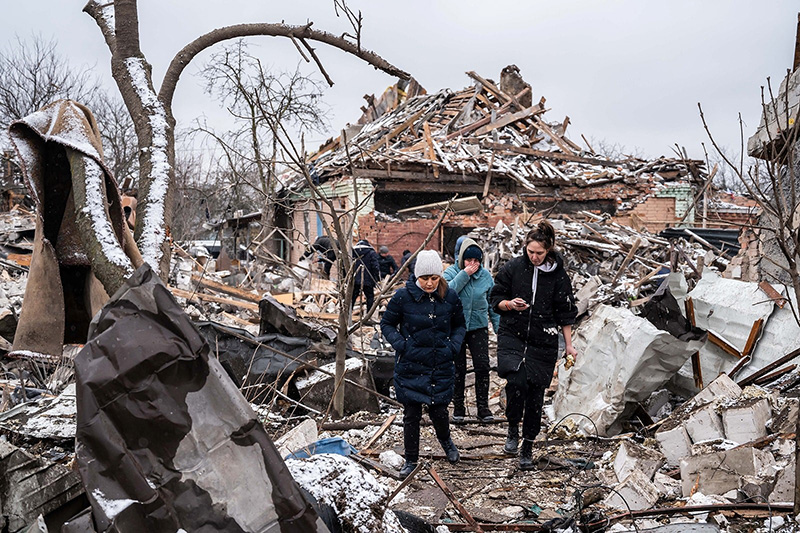
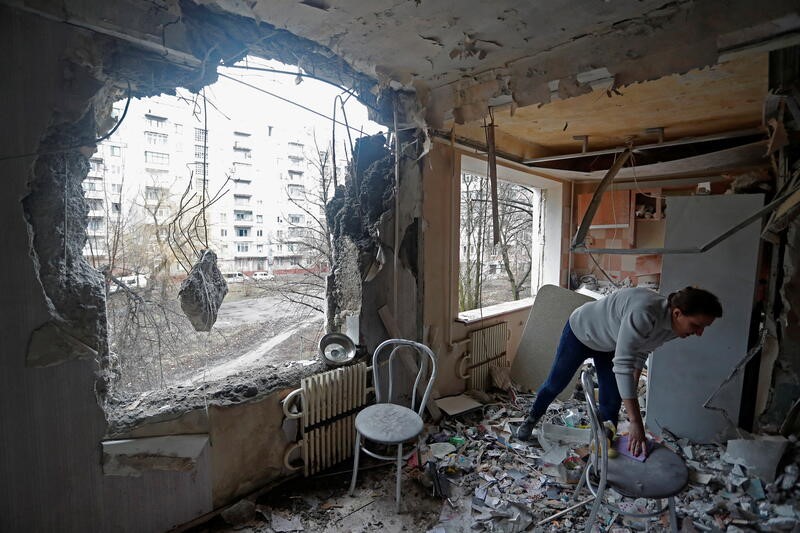
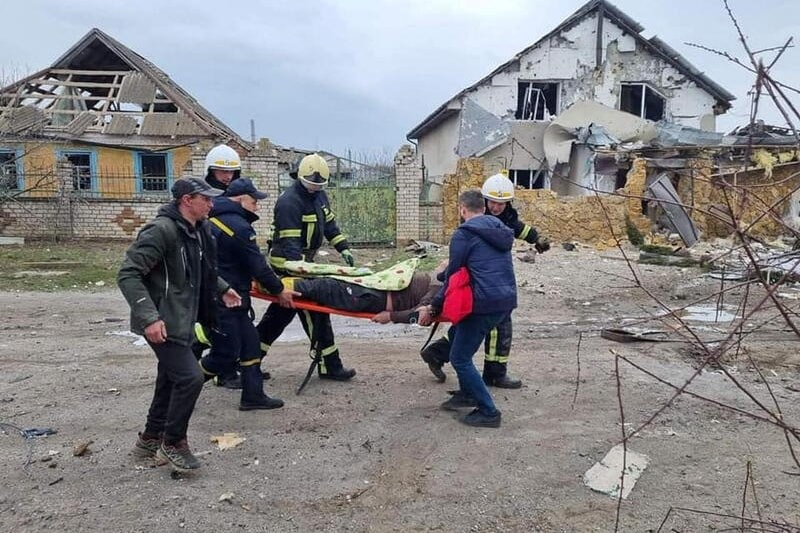
A Reuters photo shows women walking among remains of residential buildings destroyed by shelling in Zhytomyr, Ukraine, March 2, 2022. A second Reuters photo shows a woman inspecting debris inside an apartment of a residential building, which locals said was damaged by recent shelling, in the separatist-controlled town of Horlivka (Gorlovka) in the Donetsk region, Ukraine March 2, 2022. A handout picture released March 8, 2022 shows rescuers carrying a civilian injured during shelling, amid the Russian invasion of Ukraine, in Mykolaiv, Ukraine.
Top – Women walk among remains of residential buildings destroyed by shelling in Zhytomyr, Ukraine March 2, 2022. REUTERS/Viacheslav Ratynskyi
Left – A woman inspects debris inside an apartment of a residential building, which locals said was damaged by recent shelling, in the separatist-controlled town of Horlivka (Gorlovka) in the Donetsk region, Ukraine March 2, 2022. REUTERS/Alexander Ermochenko
Right – Rescuers carry a civilian injured during shelling, amid the Russian invasion of Ukraine, in Mykolaiv, Ukraine, in this handout picture released March 8, 2022. Press service of the State Emergency Service of Ukraine/Handout via REUTERS
What’s next
As the siege of major cities continues, the corridors to let civilians escape and allow aid to reach besieged areas have been the main subject of talks between Russian and Ukrainian delegations.
Ukraine's government accused Russian forces of shelling a humanitarian corridor that Moscow had promised to open to let residents flee Mariupol. The humanitarian situation there was catastrophic, a deputy prime minister said.
Russia opened a separate corridor allowing residents out of the eastern city of Sumy on Tuesday, the first successful evacuation under such a safe route.
Meanwhile, Poland said Tuesday it was ready to put all its MIG-29 jets at the disposal of the United States, which U.S. lawmakers had pushed to then transfer to the Ukrainians. The move was quickly rejected by Washington. The Pentagon said the prospect of flying combat aircraft from NATO territory into the war zone "raises serious concerns for the entire NATO alliance." Transferring such aircraft to Ukraine would mean Ukrainians could pilot the planes without additional training.
Western allies had reacted coolly to a proposal by Ukrainian President Volodymr Zelenskiy for a no-fly zone for Russian flights over Ukraine, saying participation in such a move would be tantamount to a direct conflict with Moscow.
Note
Drawings and trajectories are not to scale.
Sources
Janes; Center for Strategic and International Studies; Saab; Lockheed Martin, Baykar Technologies; Roketsa; Rosoboronexport; US Army; Black Sky, Geneva International Centre for Humanitarian Demining; Reuters
Edited by
Jon McClure, Simon Scarr and Michael Collett-White
